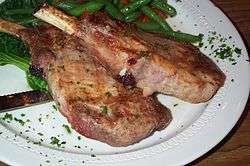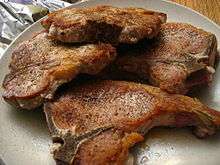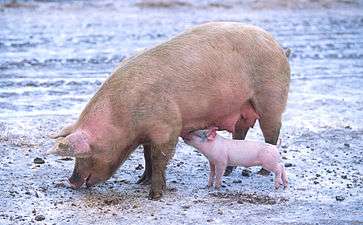Pork chop
A pork chop, like other meat chops, is a loin cut taken perpendicular to the spine of the pig and usually containing a rib or part of a vertebra. Pork chops are unprocessed and leaner than other cuts.[1] Chops are commonly served as an individual portion.

Popularity
Pork is one of the most commonly consumed meats in the world.[1][2] In the United States, pork chops are the most commonly consumed meat cut from the pork loin and account for 10% of total pork consumption.[3][4][2]
Variations
The center cut or pork loin chop includes a large T-shaped bone, and is structurally similar to the beef T-bone steak.[5] Rib chops come from the rib portion of the loin, and are similar to rib eye steaks. Blade or shoulder chops come from the spine, and tend to contain much connective tissue. The sirloin chop is taken from the (rear) leg end and also contains much connective tissue. The shoulder end produces chops that are considerably fattier than the chops taken from the loin end.[1]
The so-called "Iowa Chop"[6] is a thick center cut; the term was coined in 1976 by the Iowa Pork Producers Association. A "Bacon Chop" is cut from the shoulder end and leaves the pork belly meat attached.[7] Pork chops are sometimes sold marinated or can be marinated at home to add flavor; marinades such as a chili sauce or a barbecue sauce are common. As pork is often cooked more thoroughly than beef, thus running the risk of drying out, pork chops can be brined to maintain moistness.[8] One could also wrap pork chops in bacon to add further moistness during the cooking process.
Preparation
Pork chops are suitable for roasting, grilling, or frying, but there are also stuffed recipes. They can be used boneless or bone-in. Pork chops are usually cut between 1⁄2 and 2 inches (1.3 and 5.1 cm) thick. Improved breeding techniques have made it possible to cook pork to a lower temperature, helping it to remain juicy, while still being safe to eat.[9] United States government guidelines recommend a minimum cooking temperature of 145 °F (63 °C).[10]

See also
- List of pork dishes
- Navy Supply Corps (United States) § Pork Chop
- Pork chops and applesauce
References
- "Pork 101: Know Your Cuts - Modern Farmer". Modern Farmer. 2014-03-12. Archived from the original on 2017-09-16. Retrieved 2017-06-14.
- "The Pork Industry at a Glance" (PDF). Pork Checkoff Service Center. p. 19–21. Archived (PDF) from the original on 2015-12-11.
- "Pork Chops - National Pork Board". Pork Be Inspired. Archived from the original on 2017-06-24. Retrieved 2017-11-02.
- Kelly, Denis; Williams, Chuck; Caruso, Maren (2004-11-08). Williams-Sonoma Collection: Steak & Chop. Simon and Schuster. ISBN 9780743261869. Archived from the original on 2017-11-03.
- "Pork Cuts: A Visual Guide". cimeatbook.com. 19 August 2014. Archived from the original on 7 October 2016. Retrieved 24 January 2017.
- Devine, Jenny Barker (2009). ""Hop to the Top with the Iowa Chop": The Iowa Porkettes and Cultivating Agrarian Feminisms in the Midwest, 1964-1992". Agricultural History. 83 (4): 477–502. doi:10.3098/ah.2009.83.4.477. ISSN 0002-1482. JSTOR 40607530. PMID 19860029.
- Food and Wine Magazine August 2008
- Myhrvold, Nathan; Young, Chris (26 May 2011). "Cooking pork safely: the science". The Guardian. Archived from the original on 8 October 2016. Retrieved 24 January 2017.
- "New USDA Guidelines Lower Pork Cooking Temperature". Pork Checkoff. 24 May 2011. Archived from the original on 2 February 2014. Retrieved 30 January 2014.
- "Pork Cooking Temperature - Pork Be Inspired". Pork Be Inspired. Archived from the original on 2017-06-24. Retrieved 2017-06-14.
External links
| Wikimedia Commons has media related to pork chops. |
